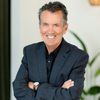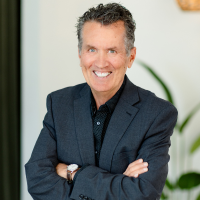The road to natural, day 4: Understanding what's possibleThe road to natural, day 4: Understanding what's possible
Inspired by activist consumers, farmers are growing ideas that could change the world.

Nutrition Business Journal Editor-in-Chief Rick Polito and aronia berry farmer Andrew Pittz set off on a journey from Boulder, Colorado, to Anaheim, California, visiting farms and interviewing industry leaders and politicians along the way to explore the connection between American agriculture and the dietary supplement and functional food industries. This is part four of five. Read the rest here.
Late in a season of historic rainfall on the typically fog-bound Northern California coast, the sun that greets us at Swanton Berry Farm seems disarmingly incongruous. The sun shines brighter than we expected, and colors echo that radiance.
The unexpected echo is the takeaway story of Swanton Berry Farm.
Just north of Santa Cruz, with only Highway One between the fields and the rhythm of the surf, Swanton Berry Farm stands as a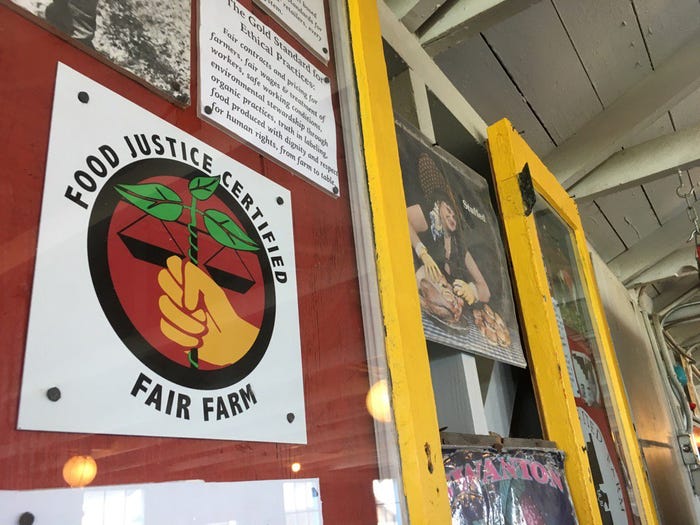 growing monument to that one farmer with one idea we’d talked about on our drive the night before, and to the rippling echo that can follow. For founder Jim Cochran, the idea was the first organic commercial strawberry farm in California. The echo that followed was exporting regenerative practices to other farmers and mixing social justice into the yield.
growing monument to that one farmer with one idea we’d talked about on our drive the night before, and to the rippling echo that can follow. For founder Jim Cochran, the idea was the first organic commercial strawberry farm in California. The echo that followed was exporting regenerative practices to other farmers and mixing social justice into the yield.
Cochran’s farm was also the first organic farm to sign contracts with the United Farm Workers. Now the farm offers the workers stock options, overtime pay, housing subsidies and health care, the whole package subject to audit by the Agricultural Justice Project. Farm manager Barrett Boaen describes the founding intentions as “a system that had dignity.”
He tells us it’s expensive, but it’s possible. And it’s been possible since the first berries were planted in 1983.
That’s what we want to hear about today—what’s possible, and how ideas, ideals and innovation echo across entire industries.
Walter Robb, too, has a wealth of experience with what’s possible. The former Whole Foods Market CEO saw 25 years of remarkable growth between his first Whole Foods job in 1991 to his transition out at the end of 2016. We reach Robb on a white-knuckle spin over Highway 17 to get MegaFood's Bethany Davis to the San Jose Airport. He tells us that change like we’d seen in the strawberry fields is more urgent and immediate than ever before.
The driving force is the farmer on the ground, but that farmer has partners by the millions—each of them marching down the aisles, smartphone in hand to research origin and ethics.
“We are seeing an activist customer who is armed with more information and more tools and platforms and is more interested in information and product than in any time since I’ve been doing this,” he tells us. Consumers aren’t just looking for information. They are looking for connection, demanding connection. “Look at the explosion of farmers’ markets,” Robb continues. “Look at the explosion of interest in small farms.”
This confluence of interest, awareness, connection and commerce is growing conscious economies. The journey from plausible to possible has never been faster, never more important, he says.
“Business is the most powerful force for change in the world,” Robb tells us.
Farmers, consumers and retailers are components of that force. The story Robb believes we can tell from our moving vantage point on the road is one of “energy” behind that force. “You’re moving towards the giant energy ball that is Anaheim,” he reminds us. Natural Products Expo West is a “mass of energy towards changing the world.”
We are still a day away from Anaheim as we talk to Robb. We feel the energy at every stop. And with each of these phone calls:
Lisa Benson, director of rural development at the U.S. Farm Bureau tells us innovation isn’t lacking in rural economies. What is lacking is the access to capital that turns innovation into opportunity. Farmers and producers need resources “to take that idea and turn it into a full business,” she explains. And, as Robb had told us, one of those resources is the relationship with consumers. “Consumers buy what they care about, and one of the thing that they care about is the story that goes along with it.” They don’t just want to know where the food came from but who it came from. The story becomes a resource. “One thing we have in these rural communities is a good story. It writes itself.”
Ed Freeman, the man who created the “stakeholder theory” of business ethics and management, tells us about growing up on a “dirt farm” in Georgia. “I don’t think my family had much of an idea of what we were doing. If we had an idea of what we were doing, we might still be doing it.” The idea his family was missing, he tells us, was that they could be part of a more benevolent system by helping build that system. Farmers need to see that. “They need to remind themselves that what they are doing is more than just trying to scratch a living out of the dirt, that there is something noble in figuring out how we cooperate to create value for each other. That’s what business is.” At least that’s what business should be, he explains. The natural products industry can help it become that, he tells us. Consumers are already demanding it. “The dominant narrative is being questioned.”
Bill Chioffi is vice president for global sourcing at Gaia Herbs, but many of the ingredients in Gaia products are grown at the company’s farm. More American farmers are climbing on board, and requirements being phased in with the Food Safety Modernization Act could make American ingredients more attractive to supplement makers. Gaia is helping grow a network of farmers, many of them young, who could supply domestic-sourced ingredients. Working with the Appalachian Beginning Forest Farmer Coalition, Gaia, university extension programs and other supplement companies are teaching farmers how to participate in the supplement economy. Small farmers can build an income stream outside of the commodity crop markets where small operations are at a disadvantage. In botanicals, the equation is weighted more toward quality. That’s what Chioffi tells the young farmers. They’re listening. “We’ve had up to 150 different farmers at events we’ve organized,” Chioffi says. “There’s a lot of traction.”
We’re not sure what to expect when we pull into the gravel lot outside battered sprawl of greenhouses at Whiskey Hill Farm. We know they are growing organic turmeric. That’s impressive enough, considering the soaring demand and the sometimes questionable supply. Nearly all the turmeric sold in supplements on the U.S. market is imported—too much of it adulterated with synthetic curcuminoids.
But Whiskey Hills Farm is also home to Blume Distillation, a biofuels operation. We are in Watsonville, at the southern fringe of the Bay Area, and I’d pictured a greasy tank of biodiesel and the digestive stench of food waste. But we walk in and see rocket science.
It’s not an actual rocket. It’s an alcohol still shaped like a rocket. But it’s actual science.
And David Blume is the actual scientist, a man who has taken a passion for turning food waste into fuel and made it into a holistic closed system of horticulture and fuel production that scoops up every outflow of energy or material and routes it back into the system to build more energy, more material.
The bulk of the material Blume and his crew are distilling into lab-grade alcohol that could be used in ingredient extraction, or burned as fuel, is waste from industrial food processing in nearby Salinas. That’s a nice piece of resource recovery, but, as Blume tells us every few minutes on his tour, “And there’s more!”
The effluent from the food waste left over from the distilling process goes into a methane digester built from pipe and pond liner for a cost Blume estimates at $2,500. The methane is then burned to provide the heat that is the essential energy input in a distillery.
And there’s more.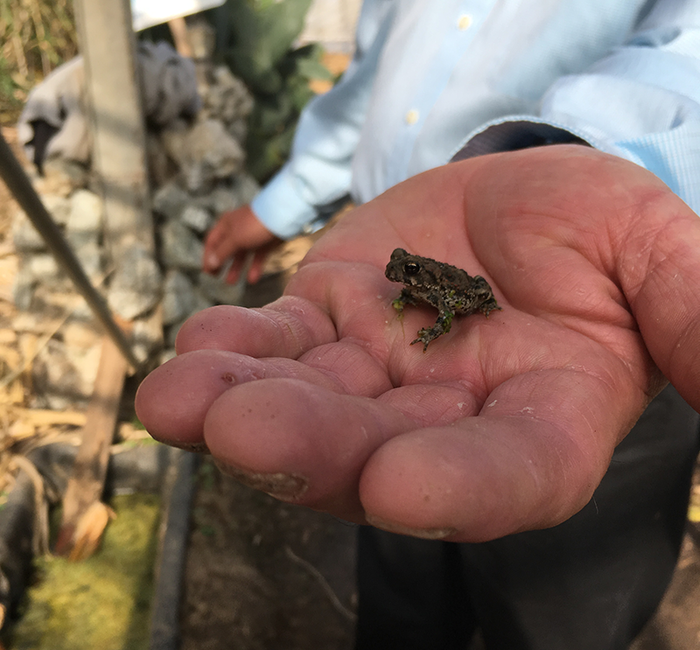
The CO2 from the burned methane is piped into the ground in the greenhouses where it feeds the turmeric and the photosynthesis process. The wastewater from the methane digester is processed through a series of ponds. The algae in the ponds pulls the nitrogen out of the water and purifies it, and then becomes fertilizer for the turmeric and other plants in the greenhouses.
And there’s more.
The last of the ponds provides homes for small frogs that provide the night crew in the Whiskey Hill pest control operation. Lizards patrol the greenhouses during the day. Both crews digest the millions of bugs and their droppings become more fertilizer.
And there’s more.
Greenhouses in the coastal fog belt require heat. They also generate compost by the ton. At Whiskey Hill Farm, water pipes running through the mounds of compost picking up the heat generated by the decomposing material. Every night the mounds are "turned" by high-pressure blasts of CO2 from the distillery.
The product might be lab-grade alcohol and organic turmeric that sells faster than the CO2-charged greenhouses can grow it, but the value proposition is in the trial and error, tinker and tweak Blume designed into the system.
.
Blume has worked with NASA. Buckminster Fuller called him for ideas (and wrote the forward for Blume’s book). He wants to see smaller refineries scaled up from his technology make sense of biofuel in a way that the Big Ag corn ethanol processing industry doesn’t. He wants to grow organic turmeric, but he also wants to grow ideas that could change farming, change fuel production, change the world.
“We don’t expect anybody to do everything we’re doing here,” he tells. “But they don’t have to. They could take any part of this and make it work.”
Andrew is having a one-degree-of-separation fanboy moment. His hero is Buckminster Fuller. The license plate on Andrew’s Ford Focus, the set of wheels we’ve lived in since leaving Boulder three days earlier, is “TRIMTAB,” referring to the smaller fin on the end of a larger rudder that helps steer massive ships. The trim tab was a central metaphor in Fuller’s philosophy of designing change.
Andrew just met a farmer who knew Fuller, who wants to create opportunities for farmers in environmentally conscious way that’s plug-in ready for the natural products and dietary supplement industries.
Andrew is a kinetic bolt of energy in his calmer moments. He’s fusion reactor arc of blinding excitement in this moment.
Of course, Blume’s closed loop system isn’t entirely closed.
In addition to the food waste from the processing plants in Salinas, he uses blocks of wood pulp left over from an organic mushroom farm in Moss Landing a few miles away. The fungus eats through the blocks, and when the block is used up, Blume adds it to the compost piles.
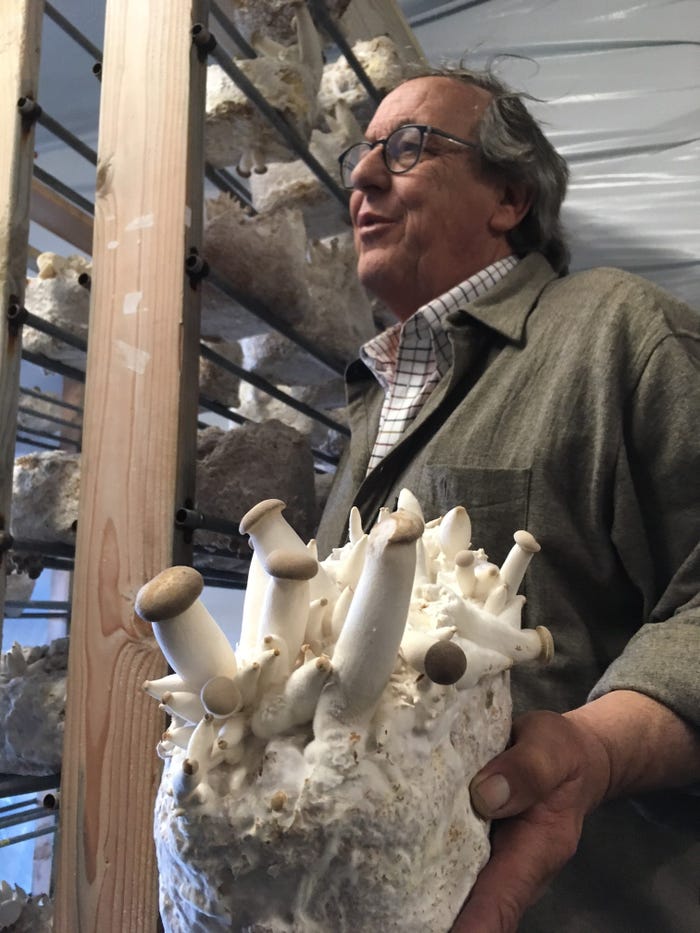
We are on our way to the mushroom farm when we leave Whiskey Hill Farms.
It’s a short drive into a long story.
John Garrone didn’t start his mycological adventures as a mushroom farmer. He began as a mushroom lover, fascinated by the fungi and their properties, both culinary and medicinal. When he found he had a talent for growing them, he began a business in a warehouse in San Francisco, When he found he had a talent for selling them, he moved to the larger operation of Far West Fungi, a collection of buildings and shipping containers south of Watsonville and not far from the Elkhorn Slough where the Carneros River greets the Pacific in a vast estuary.
Whatever fascination drew Garrone to mushrooms has not faded with the decades. This is a family operation, and it seems at times on our tour that fungus is part of the family. He heaves open the shipping container doors to reveal tree oyster, lion’s mane, maitake and a dozen other species, each with its own ornate structures and colors, each with its own particular properties. He has a palpable affection for them, and he can list off the medicinal qualities of each—qualities explained on the company website.
But he knows that the vast bulk of the mushrooms the Garrone family raises will end up in cooking pots, not healing teas or formulas. He is aware that there are supplement companies selling medicinal mushroom products, but those companies aren’t approaching him. Days later, I will see several brands and a number of products based in mushroom medicine, but the supply chain is traced to China every time. “The strength of my business is I’m not from China,” he tells us. Garrone is growing organic mushrooms with unquestionable family-farm transparency. He could grow the business and create more jobs, more opportunities, more confidence for consumers, if the supplement and functional food companies bought those mushrooms.
But the phone doesn’t ring. You can find Garrone’s mushrooms at the farmers market at the San Francisco ferry building. You can’t find them in the supplement aisle.
Five minutes in the car and only a slight rise of dunes separates us from the beach. At this hour, the shore sprawls almost deserted, and the sun lets loose the best light of the day. The high tide wipes the slate clean, and our footprints are already gone when we turn to walk back to Andrew’s car.
At the beach, every day is a fresh canvas for new footsteps and new castles in the sand. Every day is a do-over. In natural products, some ideas disappear with tides and trends, and some, like agricultural justice or biofuels, find an echo that resonates across decades.
But every day is a day for a new idea, a new ideal, a new echo.
This series is underwritten by:
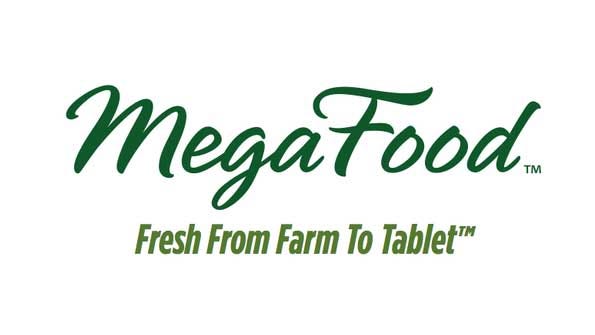
About the Author
You May Also Like
